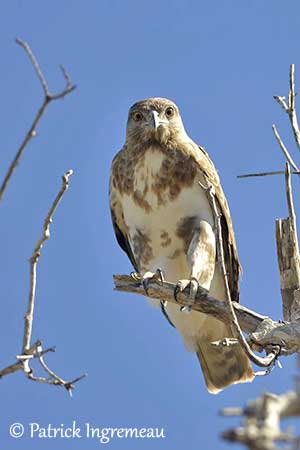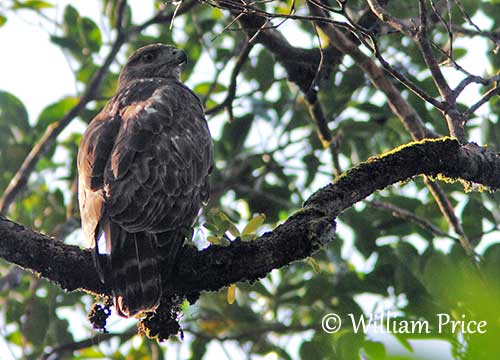
Fr: Buse de Madagascar
Ang: Madagascar Buzzard
All: Madagaskarbussard
Esp: Busardo Malgache
Ita: Poiana del Madagascar
Nd: Madagaskarbuizerd
Sd: madagaskarvråk
Mal: Bemanana, Beririna, Bevorotse, Bobaka, Hindry, tsiparahorovana
Photographers:
John Anderson
John Anderson Photo Galleries
Jean Michel Fenerole
Photos d’Oiseaux du monde
Patrick Ingremeau
TAMANDUA
William Price
PBase-tereksandpiper & Flickr William Price
Alan & Ann Tate
AA Bird Photography
Text by Nicole Bouglouan
Sources :
HANDBOOK OF THE BIRDS OF THE WORLD Vol 2 by Josep del Hoyo-Andrew Elliot-Jordi Sargatal - Lynx Edicions - ISBN: 8487334156
BIRDS OF PREY OF AFRICA AND ITS ISLANDS by Alan and Meg Kemp - Struik Publishers - ISBN: 1770073698
The Birds of Africa: Volume VIII: The Malagasy Region: Madagascar, Seychelles, Comoros, Mascarenes - Par Roger Safford, Frank Hawkins – ISBN: 1408190494, 9781408190494- Editeur: A&C Black, 2013
Wildlife of Madagascar par Ken Behrens,Keith Barnes - ISBN: 140088067X, 9781400880676 – Editeur: Princeton University Press, 2016
Birds of Madagascar: A Photographic Guide Par Pete Morris, Frank Hawkins – ISBN: 0300077556, 9780300077551- Editeur: Yale University Press, 1998
Birds of Madagascar and the Indian Ocean Islands Par Roger Safford, Adrian Skerrett, Frank Hawkins – ISBN: 1472924118, 9781472924117- Editeur: Bloomsbury Publishing, 2015
Food habits of the Madagascar Buzzard in the rain forest of the Masoala Peninsula
Global Raptor Information Network - Working to Conserve Birds of Prey in nature
Wikipedia, the free encyclopaedia
Related article: The African buzzards
Madagascar Buzzard
Buteo brachypterus
Accipitriformes Order – Accipitridae Family
INTRODUCTION:
The Madagascar Buzzard is endemic to Madagascar and is the only buzzard on the island. It is common in a wide variety of forested habitats, but it is uncommon on the deforested central plateau.
Like other Hawks of genus Buteo it takes numerous prey such as small mammals, birds, reptiles, amphibians and large insects. It nests in a large structure made with sticks placed in tree fork. Usually, only one chick survives.
The Madagascar Buzzard has stable population and is not currently threatened.
DESCRIPTION OF THE BIRD:
Biometrics:
Length: 40-48 cm
Wingspan: 93-111 cm
Weight: 342-680 g
The Madagascar Buzzard is a stocky raptor with broad, rounded wings and long tail.
The adult has dark brown upperparts, but the back is darker and contrasts with pale bars on rump and white tail base. The head may have a grey wash.
The uppertail is dark brown with narrow, grey-brown bars. On the upperwings, the flight-feathers are dark brown with narrow, pale brown barring and dark tips. The upperwing-coverts and the alula are dark brown.

The underparts are creamy-white with brown streaks on throat. Breast and underwing-coverts are more solidly streaked rufous-brown. The flanks are heavily streaked with brown, but centre of belly and vent are uniformly white. The thighs are dark brown with fine white bars. On the underwing, the whitish flight-feathers are barred brown, and we can see a dark trailing edge. The undertail is white with grey-brown bars.
The head is dark brown with darker, streaked buff crown. There is sometimes a grey wash.
The hooked bill is black with pale bluish-grey cere. The eyes are pale yellow. Legs and feet are dull yellow.
Male and female have similar plumage, but she is slightly larger than male.
The juvenile resembles adults, but the upperparts show narrow, paler tips to feathers, whereas the underparts are streaked brown. On the head, crown to hindneck are often streaked whitish or buff, and cheeks to chin are sometimes whitish. The eyes are mostly grey-brown.
RANGE:
The Madagascar Buzzard is found throughout the island, except in treeless areas.
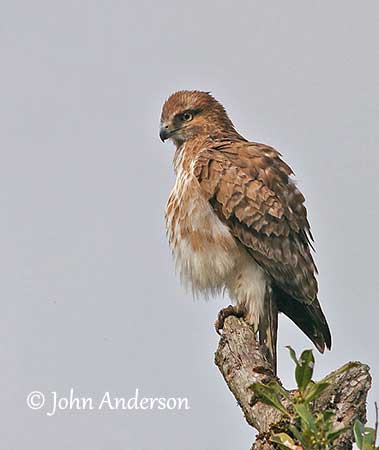
HABITAT:
The Madagascar Buzzard frequents a wide variety of wooded and open habitats from dense rainforest to open woodland. It also frequents the spiny forest, rocky slopes, thickets in mountainous areas, plantations and cultivated areas.
However, this species is absent from the deforested central plateau. It is visible from sea-level to 2,500 metres of elevation.
CALLS AND SONGS: SOUNDS BY XENO-CANTO
The Madagascar Buzzard gives loud sequence of rising notes often followed by more rapid sequence of shorter notes “peeer… piiiiiieeer… peer…peer…peer”
The main call is a nasal, plaintive squeal “yaAAah” of 1-1,5 seconds.
When the raptor is calling from perch, the notes often end in downward inflection “peeeooooooo”
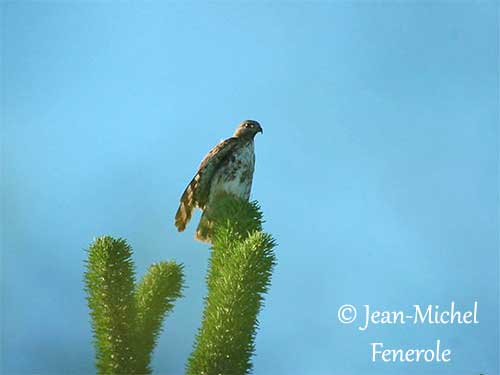
BEHAVIOUR IN THE WILD:
The Madagascar Buzzard feeds on a wide variety of prey including small mammals (rodents), birds, frogs, snakes, lizards, chameleons and large insects. This raptor is strongly associated with locust swarms. It occasionally takes some lemur species and carrion.
This buzzard searches for prey in flight, flying in pairs over the low vegetation of high ridges at 1,800/2,000 metres of elevation. It often circles above the tree canopy and dives into the trees to catch a prey.
Before to be brought to the nest, the prey is usually plucked, decapitated or partially eaten.
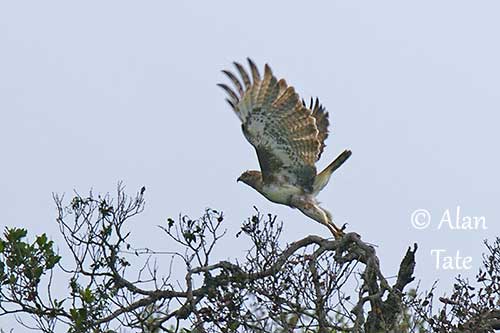
REPRODUCTION OF THIS SPECIES:
The laying occurs in September/October. The Madagascar Buzzard builds a bulky stick nest lined with green leaves. It is placed in high fork of tall tree (baobab, palm), sometimes on a rocky ledge on small cliff near the forest, or wedged into epiphytes in forest. The nest is usually between 8 and 25 metres above the ground. The nest is sometimes placed above a colony of Sakalava Weavers, but no predation was observed.
The site choice depends of ease of access for these raptors, and tall trees with narrow canopy and isolated from other trees are often chosen. The nest is reused in several following years.
The female lays 2 dull white eggs with fine dark speckles. The incubation lasts 34-37 days. The young fledge between 40 and 50 days after hatching. There is often only one surviving chick, but some pairs may rear two chicks.
The young are fed by both adults, the male bringing food at nest and the female feeding the young.
PROTECTION / THREATS / STATUS:
The Madagascar Buzzard is relatively common throughout the island, except for the treeless plateau. It is able to adapt and survive in degraded and open habitats, but it is threatened by continuous deforestation.
The population is currently stable and may be increasing as a result of forest fragmentation.
The Madagascar Buzzard is currently evaluated as Least Concern.
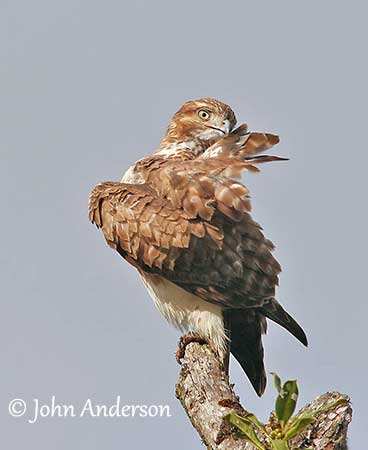
The Madagascar Buzzard is territorial during the breeding season. The pair formation occurs in July/August, followed by nest-building a few days later.
They perform typical aerial displays, soaring high followed by steep dives and wing-fluttering, very similar to displays of Common Buzzard.
The Madagascar Buzzard is sedentary.
The flight is heavy with stiff, shallow wingbeats interspersed with short glides. It frequently soars with the wings slightly upturned and pulled forwards.
